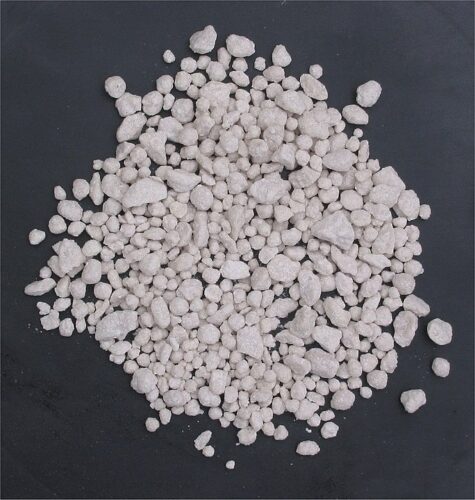Potassium is important for the water balance of plants and ensures their growth and colour. It contributes to the resistance of plants to diseases.
The potassium in all these fertilizers is the same everywhere and is quickly available to the plant, regardless of the type of potassium fertilizer. The main difference is in the added nutrients that differ per potassium fertilizer. Potassium fertilizers are completely soluble in water. This is also necessary because plants can only absorb potassium from the soil when it is in solution. The amount of potassium is therefore often stated as K2O equivalent (that is, how much it would be if it were in K2O form).
Chlorine is already harmful to plants in small amounts. All plants, except grasses and grains, are sensitive to chlorine. That is why there are low-chlorine and chlorine-containing fertilizers. The sensitivity to chlorine is partly determined by the type of soil. Damage caused by chlorine damage can be prevented by fertilizing at the right time: read the instructions on the packaging.
Raw potassium consists of potassium chloride, which is therefore poorly tolerated by most crops. Through a chemical process, potassium chloride is converted into potassium sulfate or potassium nitrate. These substances are the basis of fertilizers, the chlorine content of which is less than 2% – so low in chlorine.
The most used are:
Potash muriate (60% K2O) – also known as MOP, potash or potassium chloride, is commonly used in agriculture to replenish potassium consumed from the soil by crop growth (grain).
Potassium sulfate (43% K2O, 45% SO3) is a low-chlorine potassium fertilizer in sulphate form and intended for crops sensitive to chlorine. Potassium sulfate is widely used in the cultivation of cabbages, oilseed rape and onions.
Sulfate potash magnesia (K2O4 · MgSO4) is essentially a mixture of potassium sulfate and kieserite with 18% K2O4 and 11% MgSO4. This is a useful fertilizer to apply to nonchloride crops when there is a need for magnesia. Sulfate potash can be applied to all soil types. This potash fertilizer is applied in agriculture on heavy or medium soils in the fall before sowing (grain) and worked into the topsoil layer.
Potassium nitrate (13.5% N-NO3, 46.2%. K2O) or Indian salpetre is mainly used in intensive horticulture. Some also contain kieserite, which may be part of the raw material or may have been mixed in. Potassium nitrate is a fertilizer for all vegetables in open ground and greenhouses, berry bushes, strawberries and garden plants.

